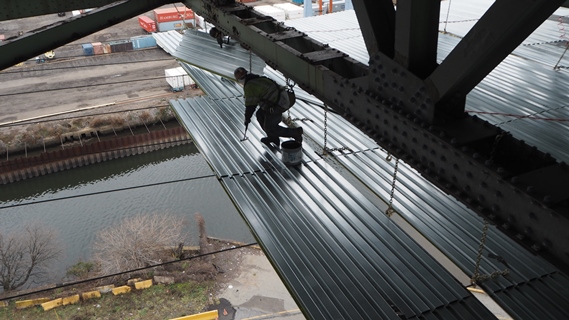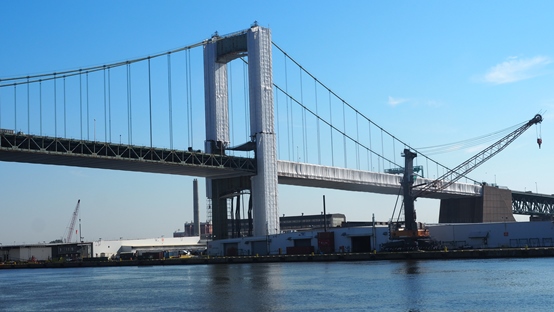Spanning 11,981 feet (3,652 m) in length with 153 feet (46.6 m) of clearance, the Walt Whitman Bridge connects suburban Gloucester City, New Jersey, to the heart of downtown Philadelphia, Pennsylvania, by going directly across the Delaware River. Built in 1957, the dark green-colored, single-level steel suspension bridge has transported millions of vehicles over the years and plays a crucial role in integrating the two states and the Philadelphia metropolitan area.
But nearly 60 years of exposure to the elements can pose quite a corrosive threat to a bridge’s structural integrity. In 2015, the Delaware River Port Authority knew it was time for a fresh coatings application, and for a job of that size, they couldn’t afford to gamble on the contractor.
“I’ve been working for the Delaware River Port Authority since 1982,” said Lou Lyras, CEO and co-founder of coatings contractor Corcon, Inc., which in 2015 began an ongoing three-year project to refurbish the bridge. “It’s a very good agency, and they’re very, very picky. They go through an extensive pre-qualification process.”
Lyras has extensive experience as a bridge specialist, and some of the work by his crew on the Walt Whitman job was featured in the recently released Bridge Brothers documentary.
Reaching Lofty Heights
One of the challenging aspects of this job for the ~65 fulltime crew members was simply accessing the elevated jobsite in the first place. Before the crew could blast the substrate and apply the new coatings, they had to set up chain-link scaffolding on the bridge and build a platform on which to work. To do this, the crew used a cable-suspended system from Safespan utilizing a corrugated deck platform.
“Building the underdeck platform is the first step on any of these types of projects,” Lyras said. “It’s completely under the whole bridge. Then once inside, we start sectioning off areas and building containment.”
In addition to accessing the underside of the bridge, which remained open to vehicular traffic throughout the job thanks to the use of roadway shields, crew members also had to take sufficient safety precautions for both the various coatings systems being applied and for working at extreme heights. Hard hats and eye protection were worn at all times regardless of the task, and depending on work location, fall protection was provided with harnesses and lanyards.

Blasters and vacuumers wore air-fed blasting hood systems supplied by Bullard, while painters were given respirators suitable for the specific coatings used and exposure levels. Air monitors were situated all around the project to record daily emissions and ensure compliance with local air quality rules.
Going Down Under
The Walt Whitman job was essentially divided into three components: the exterior steel on and mostly beneath the bridge, the exterior and interior of the towers rising up, and the cables and ropes connecting the towers to the bridge itself.
The bridge’s exterior was by far the largest part of the job, and Lyras and his team effectively split it up into seven areas. In each area, sandblasting was first on the agenda. Utilizing blasting equipment with attached dust collectors from Advanced Recycling Systems (ARS) and blast hoses from Marco, the crew removed the old, lead-based coatings to a near-white blast using steel grit. In all, the crew utilized six ARS units with 12 nozzles at any given time.
“If it looks like the job needs one machine, we’ll put two,” Lyras said of his philosophy. “If two, we put three. We man up a job [on equipment] so that we’re ahead of schedule.”
In areas where the blast hoses couldn’t reach, the crew used hand tools to achieve a Society for Protective Coatings (SSPC) Surface Preparation (SP) 11: Power Tool Cleaning to Bare Metal standard.
After blasting each area, the crew got to work on applying the first part of a three-part coatings system from Sherwin-Williams with the Zinc Clad III, an organic zinc primer. The primer was sprayed on at 3 to 5 mils (76.2‒127.0 microns) of dry film thickness (DFT), followed by a primer stripe coat. While the three-part system also included an epoxy intermediate coat and urethane finish coat, the crew often had to stop after applying the primer to allow a subcontractor to make further repairs to the steel.
“As we did the sandblasting, the repair list just grew,” Lyras said. “The steel was in bad shape, with lots of rusted members, but they don’t always reveal themselves until you do the sandblasting.” The steel repair work was handled by New York-based subcontractor Imperial Ironworks, Inc., and Lyras explained that doing the steel repairs prior to the application of the intermediate and finish coats was essential to ensuring a uniform thickness.
Following any repairs, the Macropoxy 646 epoxy intermediate and Acrolon 218 HS polyurethane finish coats were sprayed on at 4 to 6 mils (101.6‒152.4 microns) DFT each, followed by a urethane finish stripe coat at 2 to 4 mils (50.8‒101.6 microns) DFT. Including stripe coats, the total system DFT for the exterior steel was 15 to 25 mils (381.0‒635.0 microns). Brief lane closures were utilized to apply the coating system to the bridge’s parapet walls up top.
Towers, Cables, and Ropes
The towers, cables, and ropes on the bridges amounted to significantly less surface area for the crew than the exterior steel underneath, but they each still presented their own unique challenges.
For instance, coating the towers required additional rigging and a new system scaffolding approach. “It was separate scaffolding that looks like window-washing scaffolding,” Lyras explained. “It would take three to four months just to build the structure and surround the tower, and then only a few weeks to blast. There wasn’t much to paint, at all.” The towers also required a full wrapping containment system utilizing special tarps, which protected against overspray but required extra respiratory protection for workers due to the confined space.
The good news for the crew was that unlike the bridge’s underside, the towers required very minimal steel repairs. As a result, the coating process was usually uninterrupted. “Most of the corrosion from all the years was in the steel underneath,” Lyras said.
The tower exteriors were treated with the same Sherwin-Williams system for exterior steel, while the interiors were coated with a three-part system from Carboline. This system included the Carbozinc 859 as an organic zinc primer, followed by two coats of the Carboguard 635 epoxy. In all, the total system DFT was 12 to 20 mils (304.8‒508.0 microns) for the interior.
“We used Carboline on the inside because their temperatures [for application] can go much lower,” Lyras explained. Since the three-year project was completed near Philadelphia where winter temperatures can be quite low, this was particularly important. “We were painting inside into the winter months, so it gave us more flexibility,” Lyras said of the Carboline system.
Finally, two coats of Rust-Oleum’s elastomeric acrylic coating Noxyde were applied to the suspension cables and ropes connecting the towers to the bridge. “The texture is like rubber, which makes it like a complete seal,” Lyras said. “It waterproofs the cables and ropes. It’s a special coating used on many bridges, and traditionally that’s what everyone is using these days. It’s a thicker coating, so you put one coat as the full, and then check for any spots.”
Finishing Touches
The project first started in November 2015, and as we enter 2018, it is now only months away from completion!
“Most of the painting is done,” said Lyras, who added that some steel repairs on localized sections are ongoing. The project is slated to formally conclude in June 2018.
“This was actually a repeat of a bridge we did in New York, where we did the exact same work,” Lyras said. “The design is almost identical, too. So when we came to this bridge, we pretty much knew exactly what we were going to do.”
As it turned out, the script was even good enough for a movie!
